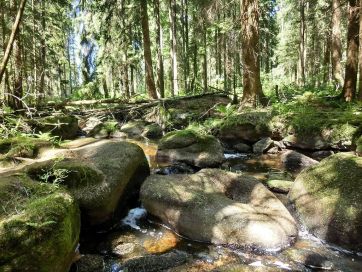The Wahles: Difference between revisions
Created page with "[[File:{{#setmainimage:Goldwäscherstein - panoramio.jpg}}|right|362px|Forest stream in the Fichtel Mountains.]] Strange, foreign people stride through the legends of the German Middle Mountains. These are the mysterious gold prospectors usually called “Venetians” about whom there are numerous tales in the lore of the Harz, Thuringian Forest, and Fichtel Mountain ranges and their people. They appear in those tales with supernatural abilities, know the hearts of the..." |
(No difference)
|
Revision as of 15:46, 22 September 2025

Strange, foreign people stride through the legends of the German Middle Mountains. These are the mysterious gold prospectors usually called “Venetians” about whom there are numerous tales in the lore of the Harz, Thuringian Forest, and Fichtel Mountain ranges and their people. They appear in those tales with supernatural abilities, know the hearts of the mountains, are familiar with all sorts of magical arts, and travel overland in dust devils.
The first printed mention about the presence of foreign gold prospectors is provided by Caspar Brusch in his “gründl. Beschreib. d. Fichtelbergs” in the first edition of 1542, revised and indexed by M. Tachariam Theobaldum Juniorem (Wittemberg, 1612).
“This mountain, and the region surrounding it, is exalted among all other areas and domains of Germany by the gold, silver, iron, and thus all of the best metals which are cooked up and created by the Sun in the depths of the earth along with sulfur and mercury. This is also well known by distant people such as the Wahles, Venetians, and Spanish who scout our country. They tend to boast that the treasures and riches hidden in Germany are better known to them (despite being foreigners) than us Germans themselves. In this manner, our people frequently spotted gypsies, Wahles, and Spaniards on said mountain. These explored nature, opportunities, and riches of this mountain and all of the surrounding regions and and even carried great riches away with them. May God reclaim such plunders and punish such peculation!
From this the saying is derived that sometimes a cow is hit by a rock from the Fichtelberg mountain, but the rock will be more valuable than the cow. With this, people want to express that there are great riches to be found on this mountain. In this mountain range people have also occasionally found books which were written in the Wahlish, French, and Dutch languages. Many locations were described and pointed out where it was possible to find gold, and even pearls and precious stones in these books. I had such a book myself[*], which was loaned to me by a priest (who is still the chaplain in Waldeck) while I was wandering all over the Fichtelberg mountain and its streams at my own expense. In this book, all kinds of strange things are written of the Cratza, the Naab, the Eger, the Main, and other rivers. It also included many signs one should search for, and with them it would be possible to find the right locations where gold, iron, beautiful stones, and pearls were hidden.”
[*] The publisher saw the copy of such a book several years ago, which had been stored in a forest village.
The unnamed second oldest author on the Fichtel Mountains dedicates a whole section to these “foreigners, namely Walloons, Venetians, Milanese, Modenese, as well as people from Brabant and Flanders” in his cited “Ausf. Beschreibung”. In this section he describes what can be “found in their registries which are sometimes lost and then recovered, but sometimes confiscated. These registries detail the rich sites which they had discovered and described on, near, and surrounding the Fichtelberg as well as Upper and Lower Saxony, in the Harz mountain range, in Bohemia, Bavaria, the Palatinate, and the Vogtland. Particularly noteworthy are the explorations of the above-mentioned regions by the Venetian Giovanni Carnero, by Johan Schotter, as well as by another Venetian named Gratiani Genedelli who spent 18 entire years on and near the Fichtelberg and finished his registry in 1531 on the Tuesday after St. Gall’s Day.980 Further texts were written by Sebastian Verso, another Venetian, as well as three other unknown authors.” Several excerpts — of which Helbrecht shares a large selection in his work “Das Fichtelgebirge. Hof, 1799” — will follow here:
[to be continued]